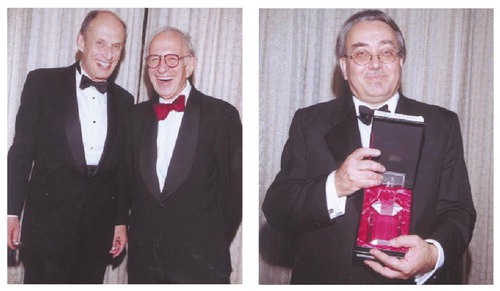NARSAD Awards Groundbreaking Mental Illness Research
Scientists who are breaking new ground in research on schizophrenia, affective disorders, and psychiatric disorders in children and adolescents were honored by the National Alliance for Research on Schizophrenia and Depression (NARSAD) in New York in October.
The Lieber Prize for Schizophrenia Research, the Nola Maddox Falcone Prize for Affective Disorders Research, the Ruane Prize for Childhood and Adolescent Psychiatry—each of which carries a cash award of $50,000—and the first Julius Axelrod Neuroscience Award went to distinguished researchers at a gala awards dinner that raised more than $1 million for research in brain disorders.
The Lieber Prize for Schizophrenia Research went to Solomon Snyder, M.D., who is chair of the department of neuroscience and the Distinguished Service Professor of Neuroscience, Pharmacology, and Psychiatry at Johns Hopkins University. The award recognizes Snyder’s work in molecular neuroscience that led to the identification of receptors for neurotransmitters and a broader understanding of the actions of psychotropic drugs. Snyder also identified nitric oxide, a gas, as a new class of neurotransmitter.
After accepting the award, Snyder said, “Though most of my research is focused on basic neuroscience, I am a fully trained psychiatrist who cared about mental illness long before my interest in research. This makes the NARSAD award more meaningful to me than any other type of basic scientific prize.”
 The Nola Maddox Falcone Award for Affective Disorders Research went to William Bunney Jr., M.D., and Hagop Akiskal, M.D.
The Nola Maddox Falcone Award for Affective Disorders Research went to William Bunney Jr., M.D., and Hagop Akiskal, M.D.
Bunney is Distinguished Professor and Della Martin Chair of Psychiatry at the University of California, Irvine College of Medicine. He helped develop the Bunney-Hamburg scale in the early 1960s, which measures symptoms of psychiatric disorders. He also demonstrated a biochemical-hormonal link of cortisol to suicidal behavior. His research has also focused on the “switch” process from depression to mania in bipolar disorder, and proposing a role for norepinephrine in depression.
Akiskal is professor of psychiatry and director of the International Mood Center at the University of California at San Diego. He has conducted extensive research in mood disorders and has studied temperament traits and their relation to various mood and anxiety disorders. Some of his work has shown that the long-term course of mood disorders is manifested by fluctuating symptoms in which illness subtypes are not discrete disorders, but stages along a continuum of symptomatic severity.
“Our data indicate that a very substantial percentage of depressed patients presenting clinically—even if dysthymic, ‘neurotic,’ or anxious—do belong to the bipolar spectrum,” Akiskal said at the awards dinner.
Ruane Prize for Outstanding Research in Childhood and Adolescent Psychiatry was awarded posthumously to Donald Cohen, M.D. Cohen was the Sterling Professor of Child Psychiatry at Yale University and director of the Yale Child Study Center. Cohen pioneered neurobiological research of autism and Tourette’s syndrome. His proposal to use the antihypertensive drug clonidine for Tourette’s opened new avenues for understanding the disorder. James Leckman, M.D., director of research and Neison Harris Professor of Child Psychiatry and Pediatrics at the Yale Child Study Center, accepted the award.
The Julius Axelrod Neuroscience Award went to Eric Kandel, M.D., Arvid Emil Carlsson, M.D., and Paul Greengard, Ph.D, who shared last year’s Nobel Prize in Medicine or Physiology. Kandel is professor and senior investigator at the Howard Hughes Medical Institute at the Center of Neurobiology and Behavior at Columbia University. He is also a member of NARSAD’s scientific council.
Kandel recorded the output of the neurons of Aplysia, a sea slug, and determined that not only do outside events change the strength of the neurons in the brain of the sea slug, but that these events shaped both long- and short-term memory. Thus, Kandel was the first to connect long- and short-term memory to physiological changes in nerve cells.
Carlsson, who is a professor and chair of the department of pharmacology at the University of Gothenburg in Sweden, discovered in the 1950s that dopamine acts as a neurotransmitter. He also used L-dopa, the chemical from which the brain synthesizes dopamine, in clinical trials to treat people with Parkinson’s disease. He also showed that certain drugs alleviated the symptoms of schizophrenia by blocking dopamine signals, and that tricyclic antidepressants affect the neurotransmitter serotonin.
Paul Greengard, Ph.D., is the Vincent Astor Professor and director of the Laboratory of Cellular and Molecular Neuroscience at Rockefeller University in New York. He is also a member of NARSAD’s scientific council. Greengard discovered that when a neurotransmitter acts after crossing a synapse, it sets off a chain of reactions involving chemicals called protein kinases, which then add or remove a phosphate group to the proteins. This changes the shape of the proteins, which in turn change the electrochemical properties of the cell, and this either makes it more or less likely to transmit messages to other cells when stimulated, he found. ▪



